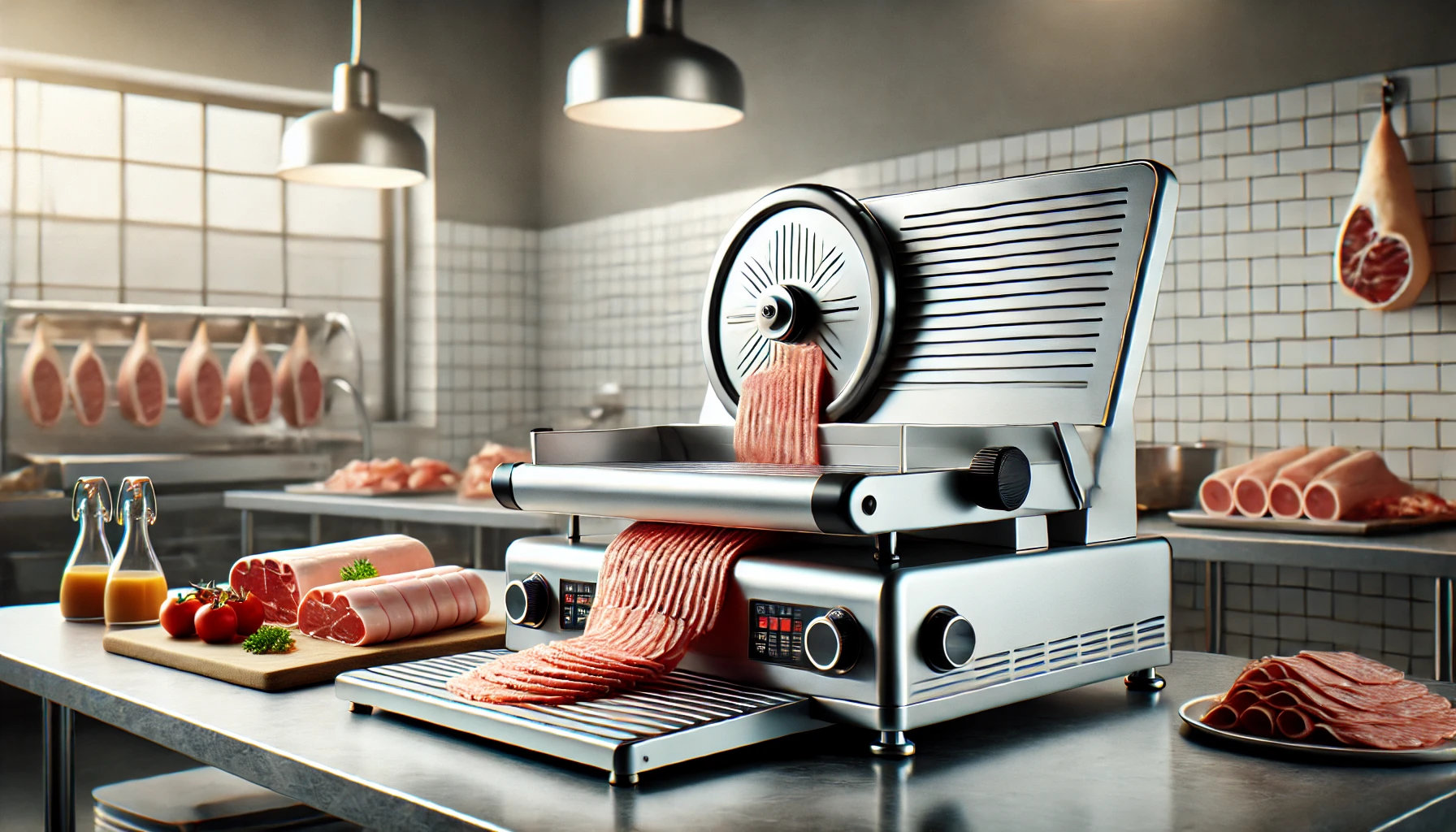If you’re in the market for a meat slicer, there are a few things you’ll want to consider before choosing one for your establishment. Whether you’re running a deli, butcher, supermarket or food truck, the best meat slicer for you will largely depend on the frequency of use and what you’re slicing.
While it may feel simpler to get a heavy-duty, multi-purpose meat slicer, not every business is going to need the same kinds of features. To help narrow your choices down, read the Restaurant Equipment buying guide for meat slicers now and find the best option for you and your business.
Blade Diameter
The blade of your meat slicer is the main key feature to consider, starting with the diameter. Not only does it dictate what you can slice, but it also impacts the thickness and types of meat or produce you can cut.
If you’re running a small or medium-sized business like a cafe, a market deli or a food truck, a meat slicer with a blade diameter of 200mm to 250mm will typically be adequate. However, if you’re a business that needs to slice through higher quantities of meat, like hotel kitchens or grocery stores, or you’re cutting larger items, you’ll want something larger. We’d recommend a meat slicer with a blade diameter of 300mm or more.
There are plenty of options spanning a range of blade diameters from high-quality brands like Hobart and Noaw.
How It's Powered
Along with the size of the blade, you’ll want to consider how your meat slicer runs. There are two modes of operation: manual and electric. Meat slicers also often come with semi-automatic or automatic slicing functionality, giving you plenty of choice when it comes to deciding how much effort you want to put into it.
Each type has its own benefits and drawbacks, choosing the best option will be dictated by the needs of your business.
Manual
Manual slicers, which rely entirely on the person using them to function, are quite rare in commercial kitchens and establishments. Due to the effort they require, most businesses use them more as conversational pieces and for small-scale use. You can still get some exceptional manual meat slicers, including the likes of the Noaw Traditional Flywheel Slicer.
Manual meat slicers are certainly a functional option and may be useful for small scale but are generally more effort than they’re worth if you’re getting through higher quantities of meat slicing.
Electric
To make life easier and get through your meat-cutting tasks a lot quicker, you’ll be more likely to opt for an electric model instead. They’re powered by a motor and don’t take remotely as much physical energy to run. The blade moves a lot faster than it would on a manual meat slicer, meaning you can get through a lot more in a significantly shorter amount of time.
They typically come with a standard plug, making them suitable for small and medium-sized businesses with moderate slicing demands. We especially recommend electric slicers from brands like Anvil and Apuro. Both offer high-performance meat slicers that are affordable and durable. They’re popular choices in many kitchens and can streamline the slicing process significantly.
Semi-Automatic vs Automatic
Electric meat slicers come in two varieties: semi-automatic and automatic. They take even more of the manual effort away, delivering a certain amount of meat-pushing automation.
Semi-automatic meat slicers will require you to push the meat against the blade but are capable of handling larger volumes of slicing than a standard electric meat slicer. Automatic meat slicers require almost no input; all you need to do is line whatever you’re slicing up, and the machine takes care of the rest. Both of these options are ideal for establishments that need to get through higher volumes, whether that’s in a deli or a supermarket.
The two brands in particular we’d recommend in this category are Hobart and VC by Benchstar. Both brands offer semi-automatic and automatic options, giving you plenty of options when it comes to finding the right one for your business.
Essential Meat Slicer Features
Adjustability
The best meat slicer option is the one that can meet your customers' diverse requirements, which is why adjustability is a crucial consideration. It’s one of the essential features of a good meat slicer, giving you more control over how you serve and sell your product. Some meats are best when cut slightly thicker, while others may be best when they’re sliced ultra-thin.
When you’re selling a broad array of products, whether that’s meat or even cheese and bread, being able to refine your cuts is essential. Make sure you’re choosing a model that allows for customisation and can deliver a wide range of slice thicknesses.
If you want the option to cut ultra-fine to extra chunky slices, something like the Anvil MSA3220 220MM would be a good choice. It’s a gravity-fed slicer that can cut anywhere between 1mm and 10mm in thickness. By contrast, if you want something that can deliver a much chunkier slice, the Hobart Semi Automatic Heavy-Duty HS9 Slicer has an extra wide 330mm blade that can cut slices as thick as 25mm.
Ease of Cleaning
As with any aspect of the food industry, hygiene is another crucial element when you’re choosing a meat slicer. Being able to keep yours clean is important for both the quality and safety of the food you’re serving.
Another one of our meat slicer buying tips is to look for a model that can be disassembled for easier cleaning. Ideally, you want to be able to remove the blade, guard, carriage and meat grip so you can wash everything thoroughly and safely.
One of the best meat slicer options for easy disassembly and cleaning is the Apuro 220mm Meat Slicer. You can remove the blade and all the main components that touch the meat, and they’re resilient enough to go into a commercial dishwasher.
Generally speaking, most meat slicers come with smooth surfaces and as few crevices as possible to reduce the chances of food particle buildup. This makes for easier cleaning and a more hygienic setup.
Blade Sharpening
Meat slicers require less effort than cutting with a knife and are also better at keeping the texture and structure of the food intact. However, to get the best slicing results, you’ll need to keep your blades sharp. This is especially important to ensure the efficiency and precision of your meat slicer.
An important piece of meat slicer buying advice is to look for models with removable blades that you can easily sharpen or one that has a built-in sharpening stone. Models like the Roband 250mm Gravity Fed slicer come with a built-in sharpening stone, making it easier to keep the blade in good condition without a lot of extra effort.
Meat Slicer Materials and Additional Features
Beyond considering the specifications, functionality and features of your prospective meat slicer, you should also look at the build quality and materials. Stainless steel or anodised aluminium are both solid materials that are resistant to corrosion, making them solid choices for commercial meat slicing.
You may also want to consider things safety features like blade guards and emergency shut-off buttons. Rubber, non-slip feet on the base of your meat slicer are also beneficial to have to reduce the chances of accidents while the meat slicer is switched on.
Complementary Appliances
If you’re organising a new setup, whether it’s in a market or deli, there are a few complementary appliances you might want to consider.
- You may want to consider investing in a commercial fridge or freezer to keep your meats chilled at the optimal temperature and to ensure food safety.
- To display your products while keeping them cool, something like a supermarket fridge or a deli display fridge is a good option for showcasing your stock.
- If you need to keep large quantities of stock on hand, options like a dry-aging fridge or cool room are ideal for maintaining high food quality even in larger quantities.
Best Meat Slicer Options by Brand
Some of the best meat slicer brands include:
- Anvil: Known for their durability and performance, we recommend them for small- to medium-sized businesses.
- Apuro: Affordable and reliable, these meat slicers are perfect for small to medium-sized operations.
- Hobart: One of the premium brands on the list, Hobart meat slicers have advanced features and are ideal for large, high-volume businesses.
- Noaw: Versatile and robust, with beautiful aesthetics, offering excellent adjustability, ease of use and a conversation piece for your shop.
- Roband: Powerful electric slicers designed for efficiency and precision.
- VC by Benchstar: Combining convenience and versatility, VC by Benchstar offer both semi-automatic and automatic options that are good value for money.
Next Steps
If you’re ready to order an upgraded meat slicer but still need help narrowing down your options, we’re happy to help You can contact us any time with any questions you may have or for a personal recommendation. Get in touch with us via email at sales@restaurantequipment.com.au or give us a call at 1300 35 25 45 now!







